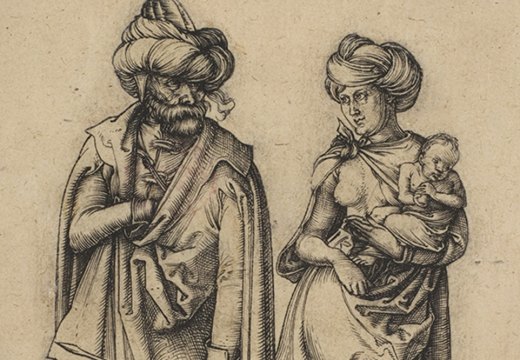 ‘Four things to see this week’ is sponsored by Bloomberg Connects, the free arts and culture app. Bloomberg Connects lets you access museums, galleries and cultural spaces around the world on demand. Download the app here to access digital guides and explore a variety of content.
‘Four things to see this week’ is sponsored by Bloomberg Connects, the free arts and culture app. Bloomberg Connects lets you access museums, galleries and cultural spaces around the world on demand. Download the app here to access digital guides and explore a variety of content.
Each week we bring you four of the most interesting objects from the world’s museums, galleries and art institutions, hand-picked to mark significant moments in the calendar.
On 26 August 1768, Captain James Cook set sail from Plymouth for Tahiti, ostensibly to record the transit of Venus – a phenomenon that would allow astronomers to accurately calculate the distance from the earth to the sun. However, the voyage’s backers, King George III and the British admiralty, had an ulterior motive. Once the celestial observations had been made, Cook was to carry on to a continent whose existence had been hypothesised for centuries, dubbed ‘Terra Australis Incognita’ (The Southern Unknown Land).
Nearly two years later, on 29 April 1770, the HMS Endeavour landed at Botany Bay – so named for its rich plant life – which is now known as Sydney. Despite finding it inhabited by First Nations people, Cook declared it terra nullius (nobody’s land) and claimed it for the British Empire.
This week, we look at the history of navigation, exploration – and the colonial histories that accompany these themes – with a selection of objects that span centuries of curiosity, innovation and accumulation.

Mostri marini et terrestri (1550), Sebastian Münster. American Museum & Gardens.
1. Mostri marini et terrestri… (Monsters of Sea and Land…) (1550), Sebastian Münster
American Museum & Gardens, Bath
Featuring a sharp-fanged fish with legs, a huge sea-snake strangling a humble fishing boat and a giant lobster gripping a sailor in its pincers, this illustration captures some of the myths and monsters that were dreamt up by the Western imagination to fill so-called terra incognita. It is taken from Sebastian Münster’s Cosmographia, one of the most popular books of the 16th century, which inspired the fearsome beasts that enlivened later maps. Click here to find out more on the Bloomberg Connects app.

Vaka (canoe) (c. 1900), maker unknown. Museum of New Zealand Te Papa Tongarewa, Wellington
2. Vaka (canoe) (c. 1900), maker unknown
Museum of New Zealand Te Papa Tongarewa, Wellington
This vaka, or canoe, was made in the late 19th century on the atoll of Manihiki in the Northern Cook Islands and can be sailed or paddled. Made of wood lashed together with coconut fibre, it has been decorated with pieces of pearl shell that spell out ‘Tauhunu’ – the name of the main village on the atoll, and a reference to Manihiki’s nickname as the ‘Island of Pearls’. Click here to find out more.

Compass (1800–99). Photo: © National Museum of Qatar
3. Compass (1800–99)
National Museum of Qatar, Doha
The magnetic compass is thought to have been invented as early as 206 BC in China, where it was originally used for divination. It wasn’t until the 9th or 10th century that it began to be used for navigation, replacing the need to rely on the stars – and a clear sky at night. This example is thought to be of British origin, and was used in the Arabian Gulf, possibly to aid with pearling or the trading of pearls, which was the main source of income for Qataris, before the discovery of oil. Click here to find out more.

LAMA robot: Lavochkin Alcatel Model Autonomous (1990–96). Photo: Michèle Favareille; © Musée des Arts et Métiers-Cnam
4. LAMA robot: Lavochkin Alcatel Model Autonomous (1990–96)
Musée des Arts et Métiers, Paris
This robot was designed by the Russian space programme for the exploration and mapping of Mars. It is able to ‘decide’ its own movements thanks to its ability to perceive and model the environment through cameras, sensors and a fibre optic gyrometer, which is based on an analogue instrument once used for navigation. Click here to find out more.
Download now
![]() ‘Four things to see this week’ is sponsored by Bloomberg Connects, the free arts and culture app. Bloomberg Connects lets you access museums, galleries and cultural spaces around the world on demand. Download the app here to access digital guides and explore a variety of content or scan the QR code.
‘Four things to see this week’ is sponsored by Bloomberg Connects, the free arts and culture app. Bloomberg Connects lets you access museums, galleries and cultural spaces around the world on demand. Download the app here to access digital guides and explore a variety of content or scan the QR code.
Unlimited access from just $16 every 3 months
Subscribe to get unlimited and exclusive access to the top art stories, interviews and exhibition reviews.














![Masterpiece [Re]discovery 2022. Photo: Ben Fisher Photography, courtesy of Masterpiece London](http://www.apollo-magazine.com/wp-content/uploads/2022/07/MPL2022_4263.jpg)
It’s time for the government of London to return to its rightful home